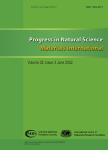版权所有:内蒙古大学图书馆 技术提供:维普资讯• 智图
内蒙古自治区呼和浩特市赛罕区大学西街235号 邮编: 010021

作者机构:Guangxi Key Laboratory of Information Materials Guangxi Collaborative Innovation Center of Structure and Property for New Energy Materials School of Material Science and Engineering Guilin University of Electronic Technology Novel Battery Materials Research Center of Engineering Technology State Key Laboratory of Featured Metal Materials and Life-cycle Safety for Composite StructuresSchool of Physical Science and Technology Guangxi University Guangxi Key Laboratory of Superhard Material Guangxi Technology Innovation Center for Special Mineral Material China Nonferrous Metal (Guilin) Geology and Mining Co. Ltd.
出 版 物:《Progress in Natural Science:Materials International》 (自然科学进展·国际材料(英文))
年 卷 期:2025年第35卷第1期
页 面:177-186页
核心收录:
学科分类:0808[工学-电气工程] 08[工学] 0805[工学-材料科学与工程(可授工学、理学学位)] 080502[工学-材料学]
基 金:supported by National Natural Science Foundation of China (No. 52173094) Scientific and Technological Plan of Guilin City(No. 20220110-1) Scientific Research and Technology Development Program of Guangxi (AB23075193) Guangxi Key Laboratory of Information Materials&Guangxi Collaborative Innovation Center of Structure and Property for New Energy Materials (Grant No. 231012-Z)
主 题:Agar-coated Lithium-ion battery Lithium-magnesium conductive layer Silicon anode
摘 要:The ultra-high theoretical capacity(4200 mAh g-1) of Silicon anode materials for lithium-ion batteries while which is one of the ideal replacement materials for graphite anodes. However, the poor electrical conductivity and greatly reduces the cycle life of the battery of Silicon material, which suffers from severe volume expansion during charge/discharge cycling leading to electrode pulverization. In this work, Agar/magnesium carbonate-coated silicon nanocomposites were synthesized by utilizing the self-solidifying property of agar. The magnesium oxide formed by the decomposition of magnesium carbonate at high temperatures mitigates the volume expansion of nanosilicon together with the derived carbon layer. Moreover, the lithium-magnesium alloy electronconducting interface layer generated by the reaction between lithium ions and magnesium oxide, which greatly shortens the diffusion length of lithium ions and electrons inside the electrode during the charge-discharge cycle. The first discharge specific capacity was 2060.2 mAh g-1, the Coulombic efficiency as high as 86.28 %, and still possesses a reversible specific capacity of 801.5 mAh g-1after cycling 200 cycles at a high current of 500 mA g-1of Agar/magnesium@Si with optimal ratio composite. The composite material used in this work largely suppresses the volume expansion of the silicon anode and contributes to the design of low-cost and high Coulombic efficiency lithium-ion batteries.